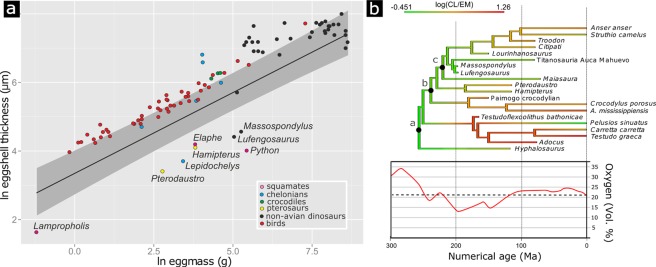Figure 4.
Relationship between eggshell thickness and egg mass in different egg-laying archosauromorphs and time calibrated maximum likelihood (ML) analysis of the ancestral states of relative eggshell thickness evolution. (a) PGLS regression line and 95% confidence band on the ln-transformed dataset. Massospondylus and Lufengosaurus represent negative outliers (see SI) emphasizing the extreme thinness of the calcareous layer compared to other dinosaurs. (b) ML ancestral state reconstruction of log-transformed calcareous layer thickness (CL) to egg mass (EM) ratios. Note that the root was set to represent the hypothesized ancestral flexible shelled condition. Nodes represent (a), Archosauromorpha, (b), Archosauria (c), Ornithodira, (d), Dinosauria, (e), birds. Note the independent acquisitions of thick eggshell in choristoderes (represented by Hyphalosaurus), chelonians, crocodiles, pterosaurs and several dinosaur clades, as well as reversals in chelonians. From the Sinemurian (199 Ma) onwards, eggshells (e.g. Testudoflexoolithus and Lourinhanosaurus) show a significant calcareous layer thickness increase corresponding with atmospheric oxygen increase. See also Fig. S4.

